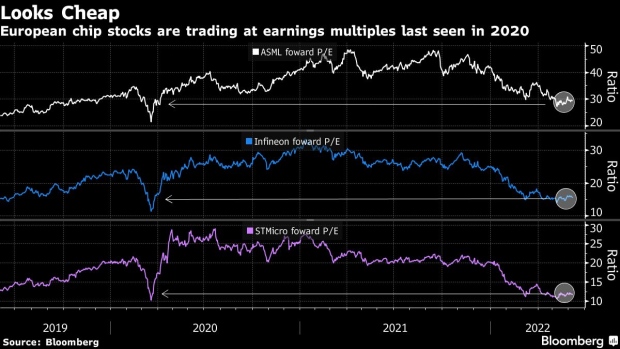Jun 9, 2022
European Chip Stocks Crumble as Investors Fast Forward to 2023
, Bloomberg News

(Bloomberg) -- European semiconductor stocks have gotten swept up in the sell-everything-tech environment even as the industry enjoys red-hot demand that’s bolstering this year’s earnings, because investors are already looking ahead to a tougher 2023.
The region’s biggest chip-related companies, ASML Holding NV and Infineon Technologies AG, have lost a quarter of their value this year and are trading at their lowest earnings multiples since before the pandemic. The eight chip companies in the Stoxx Europe 600 Index have had an average share-price decline of 26% this year, Bloomberg data shows.
Analysts expect earnings for the eight semiconductor stocks to rise on average by 41% this year, faster than the 39% predicted at the start of 2022, according to a Bloomberg calculation. The rising estimates are a result of resilient demand and the sector’s ability to command higher prices amid a global chip shortage.
“The truth is investors at the moment don’t care about the reported numbers,” said Neil Campling, head of tech, media and telecom research at Mirabaud Securities. “There is an expectation that when we get to later this year, there is going to be risk on the demand side.”
Like the rest of tech, the shares have been hurt because the fastest inflation in decades is triggering a global cycle of higher interest rates. That has hit first and foremost the high-growth, high-multiple tech companies, in software and consumer services. But the stock selloff is also affecting the more cyclical chip business, on the view that demand for industrial and consumer goods will suffer as rising rates threaten to tip the economy into a recession.
For now, none of the industry’s typical warning bells -- a decline in orders, an oversupply in chips and a drop in sales -- are ringing.
In fact, first-quarter revenue at STMicroelectronics NV, which gets more than a third of its revenue from the auto industry, topped analyst expectations. Infineon, another maker of auto and industrial chips, raised its full-year sales outlook. And Taiwan Semiconductor Manufacturing Co., the industry bellwether, projected sales growth to accelerate this year despite macroeconomic uncertainties.
Beyond those stellar headline figures, though, the semiconductor shortage is easing and stockpiles are rising at companies in the US and Europe, usually a sign of impending doom for the industry. Global smartphone shipments posted their biggest drop since the Covid outbreak, bad news for manufacturers of chips that go into these handsets. Another bad omen: Intel Corp., the largest maker of computer processors, said Wednesday that a weaker economy will affect demand and hurt financial performance.
Shares of some European chipmakers look like bargains now. Infineon trades at 16 times estimated earnings for the next year while STMicro is priced at less than 12 times profit, in both cases about a third cheaper than their five-year averages. And consensus estimates for their fiscal 2022 earnings have marched steadily higher.
But the question is how reliable those forecasts are, given the various headwinds the industry will potentially face this year and next.
Almost every semiconductor company in the first quarter pushed back against the idea that a downturn is coming, said Richard Windsor, founder of independent researcher Radio Free Mobile, making him doubt if the market has priced in risks of the next chip glut “at all.” He expects an industry decline between the fourth quarter and the first quarter of 2023.
Equipment suppliers ASML and ASM International NV may turn out to be more insulated when the industry swings from boom to bust, according to Keagan Bryce-Borthwick, an analyst at Barclays Plc. With major customers from Intel to TSMC sticking to their long-term investment plans, “there’s very little downside risks to estimates,” he said.
But for the chip sector as a whole, “we don’t have a good view yet necessarily of what the trough of the cycle looks like,” Bryce-Borthwick said. “There is just a great sense of hesitation.”
©2022 Bloomberg L.P.





